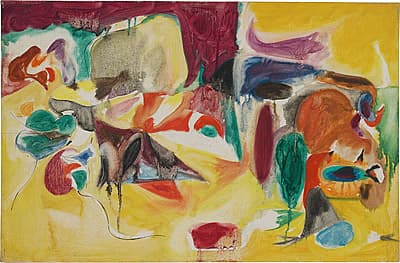
Arshile
GORKY
Turkey (Armenia)
1904
–
United States of America
1948
Untitled
1944
oil and pencil on canvas
signed u.l., oil, "A. Gorky", not dated
49.8 (h)
x 75.8 (w)
cm
Purchased 1972
National Gallery of Australia, Canberra
NGA 1972.458
© Arshile Gorky/ADAGP. Licensed by Viscopy
- the artist;
- by whom given to André Breton, New York/Paris, in 1944-45;
- by inheritance to his widow, Elisa Breton, in 1966;
- with Fourcade, Droll Inc., New York, May 1972;
- from whom bought by the Commonwealth Art Advisory Board, September 1972
- Arshile Gorky, 1904-1948: A Retrospective
- Pasadena Art Museum 24 Apr 1981 – 19 Jul 1981
- Solomon R. Guggenheim Museum 24 Apr 1981 – 19 Jul 1981
- Surrealism: Revolution by Night
- National Gallery of Australia 12 Mar 1993 – 02 May 1993
- Surrealism: Revolution by Night
- National Gallery of Australia 12 Mar 1993 – 02 May 1993
- Queensland Art Gallery 21 May 1993 – 11 Jul 1993
- Art Gallery of New South Wales 30 Jul 1993 – 19 Sep 1993
- Abstract Expressionism: the National Gallery of Australia celebrates the centenaries of Jackson Pollock and Morris Louis
- 14 Jul 2012 – 24 Feb 2013
- André Breton, Le Surréalisme et la peinture, Paris: Editions Gallimard 1965, 3rd edn, p. 201, col. illus., reproduced upside down;
- Jim M. Jordan and Robert Goldwater, The paintings of Arshile Gorky: A critical catalogue, New York and London: New York University Press 1982, pp. 86, 109, col. illus. pl. 5, cat. 293, p. 450, illus.;
- James Mollison and Laura Murray (eds), Australian National Gallery: An introduction, Canberra: Australian National Gallery, 1982, p. 31, col. illus.;
- Michael Lloyd and Michael Desmond, European and American paintings and sculptures 1870–1970 in the Australian National Gallery, Canberra: Australian National Gallery 1992, pp. 214–16, col. illus.;
- Donald Williams and Barbara Vance Wilson, From caves to canvas: An introduction to Western art, Sydney: McGraw Hill 1992, p. 251, illus. col.; 2nd ed. 1998, pp. 297–298, col. illus.;
- Sasha Grishin, ‘Monet’s Waterlilies: a reflection’, artonview no. 15, Spring 1998, pp. 4–7, col. illus.
In the spring of 1944 Gorky and his family moved to the home of his parents-in-law at Crooked Run Farm, Hamilton, Virginia. He worked there for nine months, first producing a large body of drawings that inspired the paintings of the winter months. It is likely that Untitled was painted in November or December of that year, and was based on one of these drawings.
The painting shows traces of a pencil grid, which indicates that the composition was directly transferred from a drawing. This process was common for Gorky, although it directly contradicts much of the rhetoric surrounding Surrealism’s automatism. The artist, however, carefully worked out his compositions in advance through drawings, and reused them with different colour schemes and textures; it is clear that the spontaneous influence of the subconscious mind had a limited role in Gorky’s work. His paintings are based on observations of subjects taken from nature, and carefully abstracted into their final form. Much knowledge of his technique disappeared because of the disastrous fire in 1946 that destroyed his studio, thousands of drawings and most of his paintings. The loss was one of the factors that contributed to his subsequent suicide.
Untitled survived because Gorky had already given the painting toAndré Breton, the spokesman for the Surrealist movement who fled to New York after the Nazi invasion of France. He first met Breton in the winter of 1944, at much the same time that he was working on Untitled. The painting was probably given on the occasion of Gorky's first exhibition at the Julien Levy Gallery, New York, in March 1945, to which Breton had contributed the catalogue introduction. Breton used this introduction as a concluding chapter in the second edition of his book Surrealism and painting, which also appeared in 1945.
The painting owes much to Gorky’s admiration for Joan Miró, whose works were known in New York from the inaugural exhibition at the Pierre Matisse Gallery in 1931. Although he employed similarly biomorphic forms, Gorky’s technique is more textural than Miró’s, and much denser in its composition. Untitled, like many of Gorky’s so-called abstract works, remains firmly based on landscape elements: the hills, rocks and trees that make up his observed world.
Michael Lloyd and Michael Desmond, European and American Paintings and Sculptures 1870–1970 in the Australian National Gallery, Canberra: Australian National Gallery 1992, pp. 214–16, revised Christine Dixon 2012
The National Gallery of Australia holds two oil paintings by Gorky, Untitled 1944 and Plumage landscape 1947.
